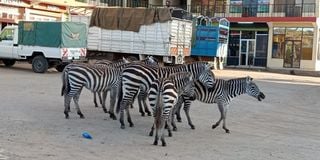Wild animals roam the streets of Maralal in search of food

Climate experts told the Nation that rainfall levels are 60 per cent below what is expected at this time of the year, which has led to reduced pasture for animals, failed harvests and severe water shortages.
Wild animals in drought-stricken Samburu County are reclaiming the local villages and the dusty streets of Maralal town from humans as they wander around in search of water and pasture.
Starved and emaciated, they’ve been sighted roaming the footpaths and alleys of the county capital scavenging for food.
Rains have failed for the third consecutive season in vast areas of arid and semi-arid lands and as the baking landscape becomes hotter and drier, animals are being forced to seek food far outside their normal range.
Climate experts told the Nation that rainfall levels are 60 per cent below what is expected at this time of the year, which has led to reduced pasture for animals, failed harvests and severe water shortages.
In some parts of the Rift Valley and northern Kenya, wild animals are already suffering from the fragmentation of their natural habitat because of ranching and industrial activities.
In the past one week, zebras have been roaming the town’s Central Business District (CBD), which is about 40 kilometres from their natural habitat at Kirisia Forest. The devastating drought has turned vast swathes of the once green and fertile land into brown.
Mr Jack Raini, an ecologist, observed that that many animals have been forced to look for food in litter bins and garbage collection points in the streets due to the effects of climate change and global warming.
“The abnormal weather conditions have affected dozens of animals and that’s why they are straying from their natural habitats into nearby communities in search of food and water,” he offered.

Starved and emaciated, they’ve been sighted roaming the footpaths and alleys of the county capital scavenging for food.
“Due to the drought, many carnivores, herbivores and pastoralists are sharing the same territory,” he added.
Drought-stricken pastoralists
The short rains that were supposed to come between October and December were extremely poor. Mr Raini said the drought shows how communities least responsible for global warming are being devastated by the climate crisis.
“Wild animals often come out to look for water and this causes human-wildlife conflicts. We expect more and more if the drought continues. Pastoralists and animals are now forced to fight for the available scarce resources,” he told the Nation.
Mr Raini regretted that although the government is supplying food aid to drought-stricken pastoralists in Samburu, nobody is thinking about wild animals. This, he noted, would eventually hurt local tourism.
“Animals, like humans, should receive be supported, otherwise they will die because the drought situation is not ending soon. Water pans are dry. This will clearly affect tourism because they come here for the elephants, giraffes and zebras,” he said.
The ecologist asked ranchers to improvise measures to protect vulnerable species, such as the construction of artificial water points. Cases of human-wildlife conflict in the region have been reported with two people being trampled by elephants in the last three months across Samburu County.
To keep their homes and farms from wandering animals, some local communities have adopted wildlife-friendly mitigation measures, but many animals still fall victim to retaliatory killings.
The Samburu County Special Programmes chief officer Daniel Lesaigor said more than 750,000 livestock have migrated from to other parts due to scorched fields and lack of water.
Mr Lesaigor said all animals in Samburu, including exotic wild animals, are threatened by the drought. “Many animals have migrated to our neighbouring counties of Baringo, Isiolo, Laikipia, Nyandarua and Nakuru. We expect more to migrate because of the biting drought,” he said.
According to the National Drought Management Authority (NDMA), more than 2.8 million people are in dire need of food aid across the arid and semi-arid counties (Asal).
The NDMA says the drought spell experienced in Kenya has so far led to the deaths of more than 1.4 million livestock in at least 15 pastoral counties. Livestock remains the economic mainstay for nomadic pastoralists and when they die, it risks human lives as well.
In September, the government declared drought a national disaster as many people across the Asal region find it difficult to access food and water.
[email protected]





